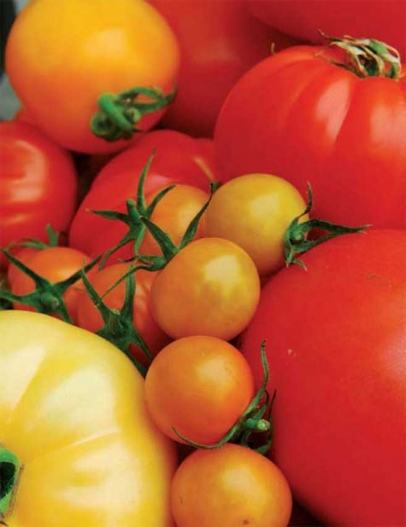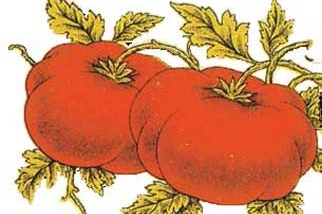In The Garden: The Forecast Calls For Tomatoes
Whether you realize it or not, we are once again on the verge of another tomato season. It’s time to assess the options laid before us in seed catalogs, and soon to arrive at our local nurseries. What action should we take? I have for years kept track of the tomatoes I have planted, harvested and eaten in something I refer to as the Swallow Rail Farm Tomato Trials. I take the selection, planting, cultivating and eating of a tomato rather seriously and I am often asked to dispense advice about it, so a written record seems to make sense.
As I look back through the tomato trials, the determining factor between success and failure is partly due to the tomato variety and largely due to the weather. The ideal Bluegrass Region summer for tomatoes rarely plays out, but here is my description nonetheless:
A sunny April allows the soil to warm to something above 58°, in time for an early May planting that proves frost-free. Tomatoes are tropical, after all, so they like their roots planted in warm soils and their leafy outer parts in equally warm ambient air temperatures. We have a soaking rain once a week to provide adequate moisture to the newly planted tomatoes, but not so much that the soil gets waterlogged and the roots become starved of oxygen. Daytime temperatures do not go above 87° and nighttime temperatures do not drop below 65°. A slight morning breeze dries the dew from the foliage without any gusts that can level the plants, cages and all. No heat wave enters the record book so the tomato continues to flower, set fruit and ripen. It is a season unhindered by too wet, too dry, too cold or too hot. Squirrels and crows find berries elsewhere because the weather has been so perfect. We pluck the first ripe tomato and enjoy the best BLT of the season before July 4.
Oh, how I long for a perfect tomato summer!
Perhaps this year will bring it, but if not, here’s what you can do to get a reasonably good crop of tomatoes out of your garden. First, determine the piece of land where the roots will spread and the plant will dwell. Drainage is the most critical component, in my opinion, for healthy tomato plants. Too wet and the roots languish as they are starved of oxygen. Add lots of composted organic matter such as chopped leaves or composted manure to improve drainage and soil fertility. This is also how you will feed your tomato a slow release of nutrients throughout the entire season, so don’t skimp on the amendments.
At planting time believe in your tomato’s tropical heritage and don’t set it out too early and subject it to cold nights or a late April frost. This is the second critical component: Soil and ambient air temperatures need to be warm. The USDA Agriculture Research Station in Urbana, Illinois, makes a strong case for patience. According to their research, tomato plants that experience night time temperatures below 50° have their circadian rhythm out of sync. This means that physiological responses such as photosynthesis, which happens during the day; and nighttime activities such as processing sugar from starch, are delayed within their 24-hour cycle. If the photosynthetic metabolism is off, the plant languishes. Here’s why: If the plant starts to process sugar an hour late, it consequently starts to photosynthesize and hour late. If this cycle continues for a week, then you have only half the amount of time necessary spent on complementary metabolic functions. (That’s wonk talk for the reason you might be at a disadvantage if you plant to early. Tell that to your neighbor across the fence.)
When you plant, pinch off the lower sets of leaves and sink the plant as deep as you can. If you need to lay the stem on its side in the hole then do so; additional roots will develop at the leaf nodes thus making a stronger plant in the long run. At this early stage you are better off with more of the plant underground than above. Once the plant is set, mulch it well in order to control weeds, prevent soil from splashing on the plant (which is one of the primary ways that disease spreads to your plant) and to moderate soil moisture (important in controlling blossom-end rot). Use any natural mulching material; I typically use newspaper with grass clippings or pine needles on top because I have a free source of either at any given time. Additionally, the newspaper–grass clipping combo works great as winter mulch for weed control; by next spring it has broken down enough that I simply turn it back into the soil.
The mulching routine is my third weapon: It cuts down on the spread of disease, manages weeds and moderates soil moisture and temperature, which keeps the plant producing. Tomatoes rather like being a bit on the dry side; rapid fluctuations in soil moisture cause one of the most common tomato conditions know as blossom- end rot. As plants fluctuate between too wet and too dry a calcium deficiency develops that causes the blossom end of the fruit to rot. You can avoid all of this with a good layer of mulch. Fluctuations in available moisture (and daytime temperatures in the 90s) also contribute to blossom drop, leaf curl and splitting fruit.
I depend on my rich garden soil to feed my plants, but I also work a little kelp into the hole at planting time and water in some diluted fish emulsion from time to time. Over-fertilization can stress the plant so compost is far superior to weekly conventional stimulants. For example, too much nitrogen will encourage leafy growth at the expense of bloom. Conversely, the lack of magnesium, which aids in chlorophyll production and respiration, can also delay fruit set. The solution: composted organic matter or manure delivers a slow, healthy dose of both.
Healthy plants that receive a slow, natural source of nutrients and have adequate moisture and excellent drainage will resist pest problems on their own. If you rotate your crop, keep the garden weed-free and mulch your plants, you will further avoid many of the diseases that plague tomatoes. Remove leaves as they appear infected and don’t inadvertently spread an infection by handling healthy plants afterwards.
Over the years I have had several winners of Swallow Rail Farm tomato trials. Last year the hands-down favorite was a stout little potato leaf variety that my neighbor, Todd Bitzer, gave us. I am counting on Todd to continue in the heirloom tradition of seed-saving and presenting me with another hand-grown seedling from down the road. These are the tomatoes that have been passed down through the generations, and perhaps we will create a provenance for the perfect tomato that understands our unpredictable weather.
Jeneen Wiche raises food, writes and lives at Swallow Rail Farm in Shelby County. Find more about her at www.swallowrailfarm.com.
SWALLOW RAIL FARM
TOMATO TRIAL WINNERS
2007: Brandywine — the heirloom tomato that all others are compared to; sweet, rich and spicy. Large fruit, average yield but so good tasting.
2007: Cherokee Purple — not a high yielder but the dark purple fruit has a rich and sweet flavor that keeps it in the top favorites despite poor ripening in high heat.
2008: Momotaro — near perfect fruit like a hothouse tomato but with real flavor. Sweet and tangy, heat tolerant, crack resistant and stores well. Not always easy to find, so if you do grab it, it will become a favorite.
2008: Pineapple — a large yellow tomato with flecks of red inside and out; it’s a great big slicer that sometimes cracks at the shoulders, but is still worth it because of its full-bodied tomato flavor.
2009: Quick Pick — early to ripen and reliable all summer long with a small, uniform fruit; stores well and tastes like a little tangy tomato. When weather thwarted other tomatoes from ripening, Quick Pick came through.
2009: Hillbilly (aka Flame) — beautifully streaked red, orange and yellow, this large tomato may crack like Pineapple, but the large fruit is forgiving under the knife with plenty left to eat. It is downright delicious, juicy sweet, low-acid and high yielding.
2010: Marglobe — a determinate tomato that is well-behaved on all fronts; it is disease resistant, compact and high yielding. The fruit is sweet with thick skin, which makes it a good candidate for canning since the crop ripens en mass and stores well.
2010: Black Prince — early to ripen with medium-sized fruit that has a rich flavor; it did exceedingly well when the heat of the summer stymied most others in the garden in 2010.
2011: Ox Heart — unusual heart-shape fruit and a very meaty texture makes this a favorite. The best way I can describe its flavor is “perfumey.”
2011: Aunt Ruby’s German Green — of the green varieties this one has a more complex flavor closer to sweet than tart. The large green fruit softens and takes on a faint red blush when it is ripe.






